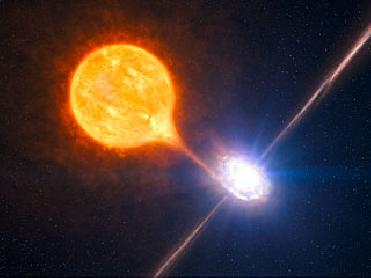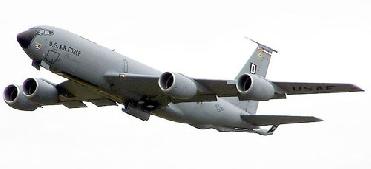
The stellar black hole belongs to a binary system as pictured in this artist�s impression. ESO Photo.
CHILE (BNS): Astronomers have recently uncovered the most powerful pair of jets ever seen from a stellar black hole.
Scientists have made the astonishing discovery with the help of observations made using ESO's Very Large Telescope and NASA�s Chandra X-ray telescope.
The object, also known as a microquasar, blows a huge bubble of hot gas, 1000 light-years across, twice as large and tens of times more powerful than other known microquasars.
"This black hole is just a few solar masses, but is a real miniature version of the most powerful quasars and radio galaxies, which contain black holes with masses of a few million times that of the Sun," Manfred Pakull, lead author of the findings, was quoted as saying in a news report by the European Southern Observatory.
Black holes are known to release a prodigious amount of energy when they swallow matter. It was believed that most of the energy came out in the form of radiation, predominantly X-rays.
However, the new findings have shown that some black holes can release at least as much energy, and perhaps much more, in the form of collimated jets of fast moving particles.
As per the findings, the fast jets slam into the surrounding interstellar gas, and thus result in heating it and triggering an expansion.
The inflating bubble contains a mixture of hot gas and ultra-fast particles at different temperatures.
"The length of the jets in NGC 7793 is amazing, compared to the size of the black hole from which they are launched. If the black hole were shrunk to the size of a soccer ball, each jet would extend from the Earth to beyond the orbit of Pluto, added co-author Robert Soria.
Research scientists are confident that this new finding will in understanding the similarity between small black holes formed from exploded stars and the super massive black holes at the centres of galaxies.
The gas-blowing black hole is located 12 million light-years away, in the outskirts of the spiral galaxy NGC 7793. From the size and expansion velocity of the bubble the astronomers have found out that the jet activity must have been ongoing for at least 200 000 years.
 Previous Article
Previous Article Next Article
Next Article













The Indian Air Force, in its flight trials evaluation report submitted before the Defence Ministry l..
view articleAn insight into the Medium Multi-Role Combat Aircraft competition...
view articleSky enthusiasts can now spot the International Space Station (ISS) commanded by Indian-American astr..
view article